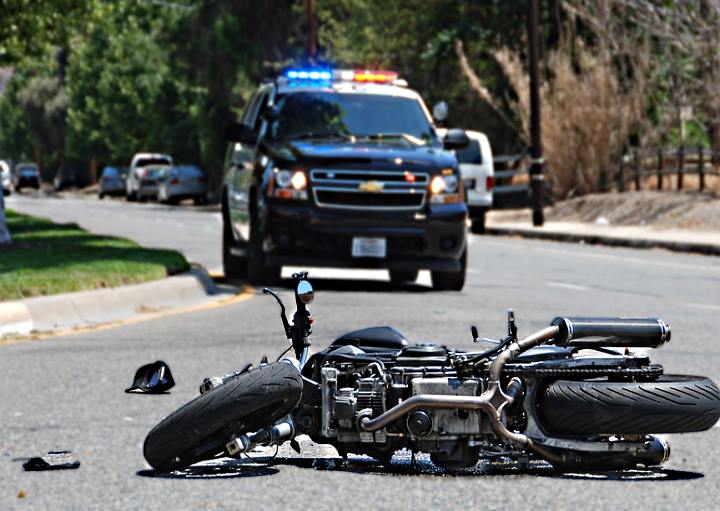Recent Post
The Importance of Travel Insurance: Why You
Dec 27, 2023

Andy Wegener
Apr 12, 2023
When Rubber Meets Road Rash:
The (Sometimes) Comedic Hazards of Hog Handling
6 minutes
h, the open road. The wind in your hair, the bugs in your teeth, the asphalt scraping your knees and elbows - as a motorcycle rider, you know the feeling. They say laughter is the best medicine, so let's explore the comedy of errors that lead to the tragic drama of motorcycle crashes. Grab your helmets, folks; we're about to take a journey into the wild world of two-wheeled disasters and uncover the secrets to avoiding them - all while trying not to grin too obviously.
Part 1: The Throttle and the Damage Done
The number one cause of motorcycle crashes is, ironically, the thing that makes them so much fun: speed. Picture it: You're tearing down the highway, the wind at your back, the world blurring by, and suddenly, you notice a curve up ahead. Your reaction? "Eh, I can take it."
Of course, the curve had other plans. The next thing you know, you're sliding down the road, leaving a trail of sparks and obscenities in your wake.
The best way to avoid speed-related crashes is to remember this simple mantra: "Slow in, fast out." Approach curves with caution, and gradually increase your speed as you exit. This not only keeps you safe but also makes you look like a pro. After all, there's nothing more embarrassing than a show-off with road rash.
Part 2: Just the Two of Us (and the Gravel)
Picture this: you're out for a leisurely weekend ride with your best bud, cruising side by side like a pair of modern-day Easy Riders. You come to a gentle bend in the road, and you both lean in.
But then, disaster strikes: your buddy's tire hits a patch of gravel, and he takes a dive like Mark Marquez after a questionable pass. You panic, slam on the brakes, and join him on the ground in a symphony of grinding metal and colorful language.
The moral of the story? Space is your friend. When riding with others, give yourself plenty of room to maneuver, especially around curves. If you're riding in groups of 3 bikes or more, ride in a staggered formation. And keep an eye out for hazards like gravel, sand, or - my personal favorite - the occasional tumbleweed.
Part 3: The Urban Jungle
City traffic is like the world's most frustrating game of Frogger. Cars, buses, pedestrians, cyclists - it's enough to make even the most experienced rider feel like they're navigating an obstacle course.
Enter the dreaded left-turner: the bane of every motorcyclist's existence. It's the moment when an oncoming car decides to make a left turn directly in front of you, leaving you with only two choices: slam on the brakes or become one with their windshield.
To avoid this all-too-common crash, stay vigilant and be prepared to react. Keep an eye on the wheels and front end of oncoming cars, as they'll often betray a driver's intentions before they even signal. And if you're approaching an intersection, consider flashing your high beams or giving a quick honk to make your presence known.
Part 4: The Lean, Mean, Sliding Machine
Ohhh, the thrill of leaning into a curve, defying gravity, and feeling the sweet embrace of centrifugal force. It's one of the most exhilarating parts of motorcycling, but it can also lead to a dance with disaster when done incorrectly. Enter the low-side crash: when a rider leans too far into a curve, loses traction, and finds themselves sliding across the pavement like a human shuffleboard puck.
The key to avoiding this type of crash is to look where you want to go and trust your instincts. As you enter a curve, focus on the exit, and your body will naturally guide your bike through the turn. Also, make sure your tires are in good condition and properly inflated, as poor traction is the number one cause of low-side crashes.
Part 5: The Art of Braking Bad
When it comes to stopping a motorcycle, there's a fine line between a graceful deceleration and a faceplant. Panic stops are a leading cause of motorcycle crashes, often resulting in a high-side crash where the bike flips and sends the rider tumbling through the air like a ragdoll.
To avoid this, practice your emergency braking technique in a safe environment. Learn how to apply both the front and rear brakes smoothly and progressively, and always remember the golden rule: squeeze, don't grab.
Part 6: The Great Escape (Route)
One of the most dangerous things a motorcyclist can encounter is a blocked escape route. Picture it: You're cruising down the highway, boxed in by traffic, when a car ahead of you slams on the brakes. With nowhere to swerve, you have no choice but to plow into the back of the car and become the world's most unfortunate hood ornament.
To avoid this potentially fatal scenario, always be aware of your surroundings and have an escape plan in mind. Maintain a safe following distance, and whenever possible, position yourself in a lane with a clear path to swerve if needed. And remember, an ounce of prevention is worth a pound of cure - or, in this case, a ton of twisted metal and broken bones.
Part 7: The Track Day Tango
For the speed demons among us, track days offer a chance to push our bikes to the limit in a relatively safe environment. But even on the racetrack, crashes are an ever-present danger. From high-speed get-offs to pit lane pile-ups, there's no shortage of ways to end your day with a spectacularly expensive bang.
To minimize your risk at the track, invest in proper protective gear and take the time to learn the proper racing techniques. Get to know the track layout, identify the tricky sections, and work on your skills gradually. Remember, there's no prize for being the fastest rider in the ambulance.
Part 8: The Perfect Storm
Sometimes, despite our best efforts, the universe conspires against us, and we find ourselves in the midst of a crash waiting to happen. For example, imagine cruising along a scenic coastal road on a beautiful, sunny day. Suddenly, a storm rolls in, and you find yourself in a torrential downpour, navigating tight curves with slick pavement and poor visibility.
In situations like these, it's essential to stay calm, maintain a slow and steady pace, and be extra vigilant for hazards. And, if conditions become too treacherous, it's always better to pull over and wait it out than to become a cautionary tale.
Part 9: The Social (Media) Disaster
Nowadays, it seems like everyone's got a camera, and there's no shortage of riders eager to show off their skills (or lack thereof) on social media. From daring wheelies to ludicrous top speeds, these viral sensations often end with a spectacular crash - and, occasionally, a one-way ticket to the hospital.
The lesson here is simple: Don't be that guy (or gal). Ride within your limits, respect the road, and save the theatrics for Hollywood.
Part 10: The First-Person Fiasco
Now, let's dive into a real-life example of one of these crash scenarios in action. It happened to me just last year, and it's a tale I won't soon forget. There I was, cruising down a winding country road, enjoying the smell of freshly cut grass and the sound of birdsong. Little did I know, disaster was lurking just around the bend.
As I approached a sharp curve, I noticed a car coming from the opposite direction. For a brief moment, our eyes met, and I could see the driver's panicked expression as they realized they had taken the turn too wide. Before I knew it, the car was careening into my lane, and I had nowhere to go.
Time seemed to slow down as my instincts kicked in. I remembered the golden rule: "Slow in, fast out." I applied the brakes gently but firmly, leaned into the turn, and somehow managed to slip past the car with mere inches to spare.
As I pulled over to catch my breath and give the driver a piece of my mind, I realized how lucky I was to have escaped unscathed. It was a sobering reminder of the importance of always being prepared, staying vigilant, and never taking anything for granted when you're on two wheels.
Part 11: Target Fixation - Yikes!!
Ever went down the road and identified an obstacle, say one of those bumpy little metal reflectors which we riders dare not to hit? Next thing you know, bingo, with surgical precision you hit it right on center! Why did this happen? You were trying to avoid that little bastard!
"You Go Where You Look" is a well-known phenomenon among riders, describing an essential aspect of motor control and rider psychology. It asserts that a rider's direction of travel is strongly influenced, if not dictated, by where they focus their gaze. This principle is fundamental to navigating turns, avoiding obstacles, and maintaining general control over the motorcycle. By directing their eyes towards where they want to go rather than where they currently are, riders are more likely to maintain balance, effectively steer their motorcycles, and respond quickly to changes in the riding environment.
The reason why "You Go Where You Look" holds true is deeply rooted in human neurobiology and the way our brains process visual and spatial information. As humans, our actions are often aligned with our visual focus because our brain uses visual cues to coordinate movements. In the context of motorcycle riding, when a rider focuses their eyes on a specific point, e.g. the apex of a curve (yeah we all love that one…), the brain processes this information and sends signals to the body to guide the motorcycle towards that point. This mechanism can be incredibly beneficial in controlled circumstances, like navigating a turn, but it can also lead to dangerous situations if the rider fixates on potential hazards, a phenomenon known as target fixation. Thus, understanding and applying the principle of "You Go Where You Look" is critical for safe and effective motorcycle riding.
In Conclusion:
Crashing on a motorcycle is never fun, and don’t get me wrong - there’s nothing comedic about crashing your motorcycle like mentioned in the beginning, but with a little knowledge, practice, and a healthy dose of self-awareness, you can minimize your risk and keep the rubber side down. So, whether you're weaving through city traffic, carving up twisty mountain roads, or chasing the checkered flag at the track, remember to stay safe, ride smart, and always respect the road.
After all, as motorcycle riders, we're part of a unique and passionate community - one that understands the inherent risks and incredible rewards of our chosen mode of transportation. So let's look out for one another, share our experiences (and near-misses), and keep the laughter going - because the best rides are the ones that end with a smile and a story to tell.
Prologue: Just Scratching the Surface
Before we dive headfirst into the whacky world of motorcycle mishaps and near-death experiences, I'd like to take a moment to acknowledge a simple truth: the reasons for crashing and the tips to avoid them that we'll explore in this blog post are, by necessity, only the tip of the iceberg.
As any seasoned rider knows, the art of motorcycling is a complex, nuanced, and ever-evolving pursuit, and no single article (no matter how entertaining or witty) could possibly hope to cover every aspect in-depth.
That being said, my goal is to provide a light-hearted and informative overview of some of the most common crash scenarios and basic strategies for avoiding them. I encourage you, dear reader, to treat this post as a starting point for your journey towards mastering the fine art of not becoming a human projectile. There are countless resources out there - books, videos, courses, and experienced riders - eager to help you delve deeper into the intricacies of motorcycle safety.
So, with that caveat in mind, let's saddle up, rev our engines, and embark on a wild ride through the hilarious hazards of hog handling. Just remember to keep your wits about you, your eyes on the road, and your sense of humor intact - or as I like to call it “keep the rubber on the road and the shiny side up”. After all, we're all in this together, and there's no better way to learn than by sharing a laugh at our own (and each other's) expense.







